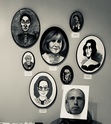Intent to Deceive
Intent to Deceive
February 14 through May 10
Oklahoma City Museum of Art
OKCMOA.com
Colette Loll is a cultural heritage crime fighter. The curator of OKCMOA’s Intent to Deceive is also the founder of Art Fraud Insights, an agency that works with the FBI to target forgeries infesting the marketplace and museums across the country. She wields an extensive knowledge of art history, a keen eye, and a ray gun that can distinguish, in seconds, the elemental composition of a painting, allowing her to compare potential forgeries to legitimate works by classical masters.
An Agent Scully of the art world.
As Loll led media through a preview of the exhibit, she spoke with a mix of disdain and respect for the five notorious fraudsters who star in the collection. It was difficult to not empathize with the frustration and cynicism of these painters who turned to fraud so they could finally make a living off their talent, the one thing that truly made them special.
I am still left with the thought that, with billions of dollars expended on art sales throughout the world, why aren’t more artists getting in on the action? Let’s break it down.
The Creators—There are artists with talent. Within that vast group, there are artists with talent and vision. And within this still fairly large group, there are artists with talent and vision and drive. And within that much smaller group, there are artists with talent and vision and drive and connections and/or luck. This final, micro-sized group is where the success is found, take or leave the talent factor. A tiny subset of the whole which achieves the recognition that is the dream of every creative soul that picks up a paint brush.
So for the artists that have talent and drive and connections, but no vision, what is left to them but fraud? Painting is what they love to do, so why not make some(read: lots of) money while doing it?
The Buyers—Collectors, museum curators, and dealers all fall victim to the classic tragedy of art appreciation: Genius is abundant, but the ability to recognize genius is rare. Each of these aficionados of the art world dream of unearthing a brilliant work, sifting through mountains of trash to find the diamond so many others overlooked. These finds fill their wallets and define their careers, proving that they are among that micro-minority of their profession that can recognize the true value of art.
They want to believe and there is no more willing fool than the faithful.
The Industry—Art is a product that has no true practical value. It serves no utilitarian purpose, yet a single painting can sell for more than a house, perhaps an entire neighborhood of houses if the provenance is right.
Art has value only because someone has assigned it value. If he/she can convince another of that value, then it can be sold for profit, though its first function is to be visually pleasing, its second function is to be old, and it’s third and most important function is to be exclusive. The pinnacle of all luxury items.
So, if you have the ability to trick your way into this grossly over-inflated market, how do you not take a shot? Why doesn’t every artist with the technical skill to create frauds not grab at the ridiculous money flowing through the art world?
Because art’s primary function is communication of soul. That is how we recognize genius, that is what elevates a craft into an art form, the merging of unique expression with technical prowess to create something almost alien to the rest of human experience: true inspiration. Inspiration touches us all at some point in our lives, a moment when our entire worldview comes into sharp focus, an incredible experience a million times more fleeting than love. Inspiration can uplift the downtrodden, alter entire industries, or drive poets mad trying to recapture that vivid clarity.
To witness a perfect creation is like gazing at a distant world, sensing that we are only seeing a sliver of the expansive emotion that brought this work into being. A visual representation of the immensity of pure inspiration.
These fraudsters, impressive as they might be, are not artists, they are craftsmen. Their function is only replication, devices of our age that will some day be replaced by machines. OKCMOA’s exhibit is a wonderfully deep exploration into this fascinating profession, but more than that, a chance to challenge one’s own perception of the true nature of art.



